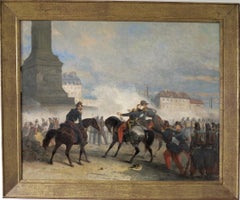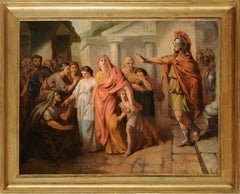Nicolas Edward Gabé Paintings
to
1
Overall Width
to
Overall Height
to
1
1
1
1
1
1
1
1
781
717
711
693
1
1
Artist: Nicolas Edward Gabé
The death of General Négrier on Place de la Bastille, Paris - France
By Nicolas Edward Gabé
Located in Paris, IDF
Nicolas Edward GABE
(Paris, 1814 - Paris, 1865)
The death of General Négrier on Place de la Bastille on June 25, 1848
Oil on canvas
Signed and dated lower right
82 x 101 cm
1849
Nicolas Edward Gabé is a 19th century artist who is still little studied to this day and yet seems to have enjoyed, according to the artistic press of the time, a certain notoriety, in particular for his seascapes.
The few bibliographical elements that we have come from the Salon booklets and tell us that the artist was born in Paris in 1814, therefore shortly before the end of the Empire.
No elements on his artistic training are mentioned in the booklets, we just know that Gabé exhibited at the Paris Salon from 1835 to 1864 where he first practiced miniature then then approached easel painting, risking himself as well in still life that the seascapes, the landscape, the portrait or the hunting.
According to press articles, he also took part in various exhibitions in the provinces such as Boulogne-sur-Mer and Marseille.
Notably, Gabé did not exhibit at the Salon his large historical canvases on the revolution of 1848, which today are of obvious documentary and iconographic interest; probably for political reasons which are easily understandable to us today in view of the historical events of then.
Gabé died in Paris at the age of 51 on January 4, 1865 with a mention in the January 7, 1865 edition of L'Union des Arts: “The death of Mr. Gabé, painter, well known in the export trade in paintings as well as to the auctioneers' hotel, whose sales it supplied through its numerous navies. “
"On June 25, 1848, in front of the barricades erected in the Bastille by the insurgents of the Red Republic, General Négrier fell to death, while he was uttering words of order and conciliation". Here are the opening lines of the tribute paid by Colonel Borgarelli d´Ison, friend of General Négrier.
General Négrier belonged to a family from Maine, brought back by Marshal Lannes from emigration. Born in Le Mans on April 27, 1788, François Marie Casimir de Négrier entered, barely 18, as a volunteer in the 2nd Light Infantry Regiment. He began in 1806 with the campaigns of Prussia and Poland, during which he earned, through his bravery, the rank of sergeant and the decoration of the Legion of Honor. He made the following campaigns in Spain and Portugal, and left, with his regiment, only for the campaign of France, in 1814, after having risen successively, by actions of brilliance and by a serious wound, to the ranks of head of battalion and officer of the Legion of Honor, with which he was provided from October 1813. The Restoration retained his rank in his regiment. After having fought and wounded a second time seriously in Waterloo, Négrier was recalled in 1816 under the second Restoration. He was appointed, in 1825, lieutenant-colonel, then colonel in 1830, brigadier general in 1836, and of division in 1841. From March 1837 he participated in the conquest of Algeria.
The Revolution of 1848 found Negrier in possession of the important command of the 16th Military Division in Lille. Quaestor of the Assembly in these times which promised to be troubled, Négrier reviewed the Place de la Concorde on June 23 at around noon various mobile guard battalions. He then took the head of 2,000 men provided by the 10th and 11th legions of the national guard and bivouacked on the Place du Palais until the next day 24. On Sunday 25 at nine o'clock, the Négrier division resumed the fight towards the Saint suburb. -Antoine. The troop gains continual advantages. At around two o'clock the column of Négrier had seized the Pont Marie: it had removed the barricades from the Quai Saint-Paul, the rue de l'Etoile, the rue des Barres...
Category
Mid-19th Century French School Nicolas Edward Gabé Paintings
Materials
Oil
Related Items
Alexander the Great in the Darius house
Located in BELEYMAS, FR
French School, Late 18th Century
Alexander the Great in the House of Darius
Oil on canvas
H. 42 cm; W. 53.5 cm without frame
Apocryphal signature lower right "Verhag..."
This painti...
Category
1780s French School Nicolas Edward Gabé Paintings
Materials
Canvas, Oil
Portrait of baron de Roisin - Gendarmerie general
Located in BELEYMAS, FR
Flemish school of the 19th century
Armorial portrait of Baron Henri de ROISIN (1787-1846)
in the uniform of a general of the gendarmerie (1835)
Oil on canvas
H. 108 cm; W. 90 cm
Bar...
Category
1830s French School Nicolas Edward Gabé Paintings
Materials
Canvas, Oil
Horse at the Blacksmith's
By Louis Henri Deluermoz
Located in BELEYMAS, FR
Henri DELUERMOZ
(Paris 1876 – Paris 1943)
At the blacksmith's
Oil on metal. Two welded plates
H. 145 cm; W. 100.5 cm
Signed lower left
Trained under Alcide-Joseph Lorentz and Charle...
Category
1890s French School Nicolas Edward Gabé Paintings
Materials
Metal
Cavalry review of the 2nd Lancers regiment
Located in BELEYMAS, FR
Georges HYON
(Paris 1840 – Saint Germain en Laye 1913)
Cavalry review of the 2nd Lancers regiment
Oil on canvas
H. 115 cm; W. 146.5 cm
Signed lower left
A student of Portalis, Georg...
Category
1870s French School Nicolas Edward Gabé Paintings
Materials
Canvas, Oil
Portrait of a woman ironing
Located in BELEYMAS, FR
Paul LUNAUD
(Brantôme 1900 – 1949)
The ironer
Oil on wood
H. 80 cm; W. 64 cm
Signed and dated on the right in the center, formerly signed lower right.
1942
Provenance : Artist's stu...
Category
1940s French School Nicolas Edward Gabé Paintings
Materials
Oil, Wood Panel
Red-haired beauty portrait oil painting on canvas by René Avigdor 19Th Century
Located in Gavere, BE
Red-haired beauty portrait oil painting on canvas by René Avigdor 19Th Century
Rene Avigdor was born in Nice and spent his career in France.
He specialized in portraits, especiall...
Category
1890s French School Nicolas Edward Gabé Paintings
Materials
Gold Leaf
$11,034 Sale Price
20% Off
H 31.89 in W 29.53 in D 4.73 in
Portrait of a couple
Located in BELEYMAS, FR
Jean-Baptiste SANTERRE
(Magny en Véxins 1651 - Paris 1717)
Portrait of a couple
Oil on original oval canvas
H. 115 cm; L. 90 cm (140 x 115 cm with frame)
Around 1695
Jean-Baptiste S...
Category
1690s French School Nicolas Edward Gabé Paintings
Materials
Canvas, Oil
Four large French family portraits
Located in BELEYMAS, FR
Suite of four large family portraits, kept together to this day. Created around 1840 by the painter Théophile Morel, who presented portraits at the Salon des Artistes Français from t...
Category
1840s French School Nicolas Edward Gabé Paintings
Materials
Canvas, Oil
Large French Oil painting On Canvas, portrait of a musketeer 19th century
Located in Gavere, BE
Beautiful Oil On Canvas, portrait of a musketeer French school 19th century
This is a French 19th century school with large dimensions .
Very decorative and exclusive portrait paint...
Category
1890s French School Nicolas Edward Gabé Paintings
Materials
Gold Leaf
$11,199
H 35.44 in W 24.81 in D 0.79 in
Portrait of young man - The artist's son
Located in BELEYMAS, FR
Auguste-Joseph Delécluse
(Roubaix 1855 - Paris 1928)
Portrait of the artist's son, Eugène Delécluse
Oil on canvas
H. 98 cm; W. 116 cm
Signed lower right
1903
Exhibition: 1903, Salon...
Category
Early 1900s French School Nicolas Edward Gabé Paintings
Materials
Canvas, Oil
Holy family under an oak tree on a gold background
Located in BELEYMAS, FR
French school circa 1870
Holy Family under an oak, after Raphaël, on gold background
Oil on canvas
H. 92 cm; W. 60 cm
This aesthetic curiosity takes up the very famous composition b...
Category
19th Century French School Nicolas Edward Gabé Paintings
Materials
Canvas, Oil
Chinese woman portrait with two fennec foxes
Located in BELEYMAS, FR
French School, circa 1950
Portrait of a Chinese Woman with Two Fennec Foxes
Oil on cardboard
H. 60 cm; W. 50 cm
Circa 1950
This painting depicts a young woman with a calm face and t...
Category
1950s French School Nicolas Edward Gabé Paintings
Materials
Oil, Cardboard
Nicolas Edward Gabé paintings for sale on 1stDibs.
Find a wide variety of authentic Nicolas Edward Gabé paintings available for sale on 1stDibs. You can also browse by medium to find art by Nicolas Edward Gabé in oil paint, paint and more. Not every interior allows for large Nicolas Edward Gabé paintings, so small editions measuring 40 inches across are available. Customers who are interested in this artist might also find the work of Gabriel Godard, Giovanni Santaniello, and Emilio Pergola. Nicolas Edward Gabé paintings prices can differ depending upon medium, time period and other attributes. On 1stDibs, the price for these items starts at $21,636 and tops out at $21,636, while the average work can sell for $21,636.


